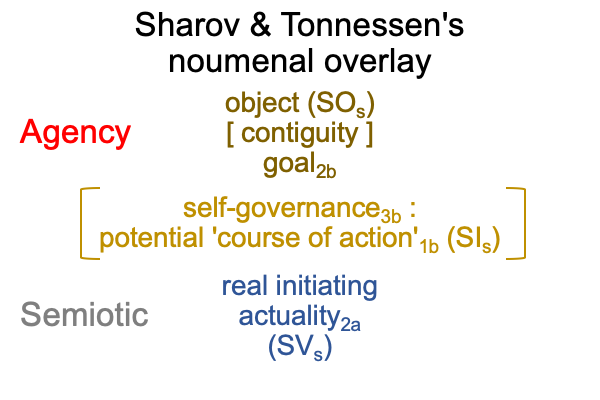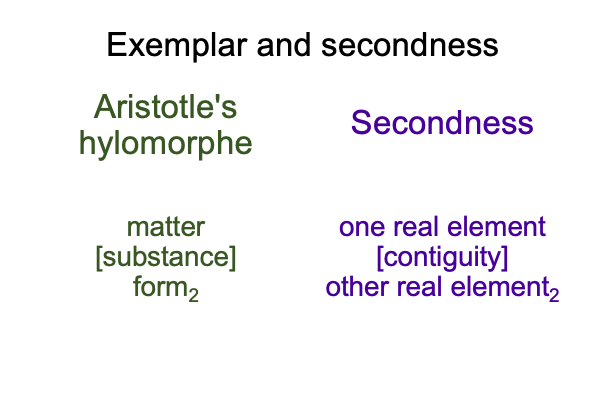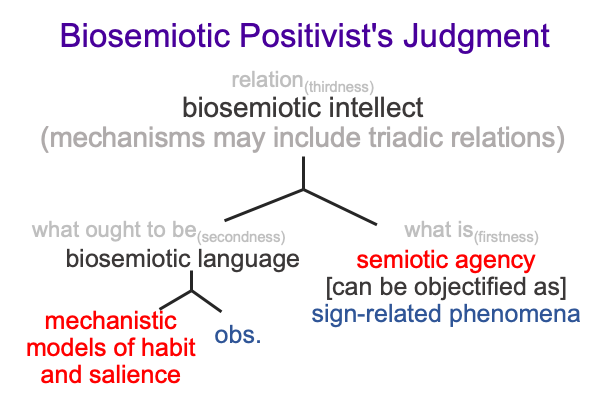0140 Part 3 is titled, “Theoretical Considerations”.
The first chapter of Part III, chapter six, is titled, “Conceptualizing Agency”.
0141 In Part I, this examiner developed a dyad for semiotic agency.
Here is a picture.

0142 In section 6.1, the authors ask (more or less), “What is the ontological status of semiotic agency?”
0143 Table 6.1 provides a list of definitions for the term.
0144 What are the attributes of agency?
0145 The first attribute is wholeness. S&T’s noumenal overlay constitutes a whole thing. This dyadic “whole thing” contains a two contiguous real elements.
The second attribute is the capacity to generate end-directed behaviors.
Agency2b fits the bill. Agency2b is a specifying sign-object (SOs) [in contiguity with] a goal.
The real elements in the above figure can be observed and measured by humans. As such, they serve as phenomena that objectify semiotic agency.
0146 The third attribute is normative constraint in the agent’s interaction with the environment. Normative constraints apply to potential ‘courses of action’1b (SIs). In fact, one of the jobs of biosemioticians is to identify normative constraints.
0147 The fourth is sign processing. Indeed, S&T’s noumenal overlay presents a sign-relation (corresponding to Peirce’s category of thirdness) as a dyadic structure, corresponding to both Aristotle’s hylomorphe and Peirce’s category of secondness.

Why is the presentation of thirdness as secondness crucial for scientific inquiry?
Secondness exhibits the logics of contradiction and noncontradiction. If a scientist consistently observes and measures certain intuitively obvious phenomena, such as SVs, SOs and goal, then semiotic agency should belong to secondness. Even though different biosemioticians hold different intuitions (as to what the corresponding phenomena are), contradictions concerning the noumenon can be discussed and resolved.
0148 The fifth attribute testifies to the weirdly unconstrained nature of semiotic agency.
In other words, Sharov and Tonnessen’s noumenal overlay veils a fully semiotic noumenon. The physical and metaphysical causalities in sign-relations are not bounded in the same way that the truncated material and instrumental causalities of natural and laboratory science are. Sign-relations entangle the material world. So, from the point of view that only observable and measurable phenomena may be mathematically and mechanically modeled, sign-relations are problematic.
It is like describing the material and instrumental causalities of a spoon without recognizing that, when mother shakes a spoon at you at dinner table, that means to sit up straight.
0149 Table 6.1 sets the stage for a declaration of the author’s point of view.
The book is peppered with such declarations. The authors take their mission seriously.
So, what is the declaration?
The time has come to bring the notion of semiotic agency “back” into science.
0150 What does this imply?
As previously discussed, this implies that the time has come for a biosemiotic version of the Positivist’s judgment.

